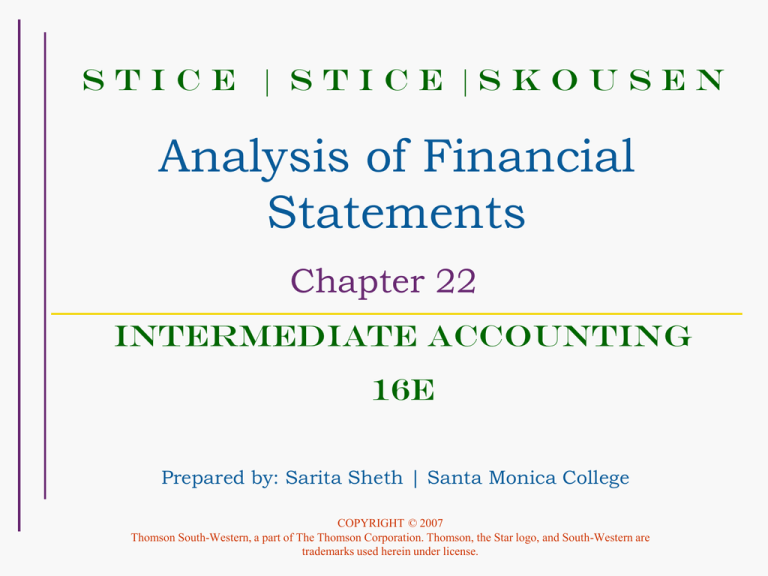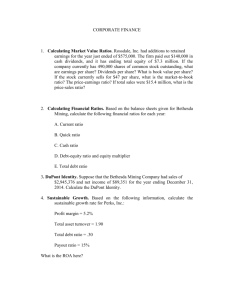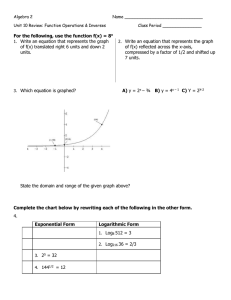Financial statement analysis
advertisement

StIce | StIce |Skousen Analysis of Financial Statements Chapter 22 Intermediate Accounting 16E Prepared by: Sarita Sheth | Santa Monica College COPYRIGHT © 2007 Thomson South-Western, a part of The Thomson Corporation. Thomson, the Star logo, and South-Western are trademarks used herein under license. Learning Objectives 1. 2. 3. 4. 5. Organize a systematic financial ratio analysis using common-size financial statements and the DuPont framework. Recognize the potential impact that differing accounting methods can have on the financial ratios of otherwise essentially identical companies. Understand how foreign companies report their financial results to U.S. investors. Describe the purpose and format of the SEC’s Form 20-F. Convert foreign currency financial statements into U.S. dollars using the translation method. Framework for Financial Statement Analysis • Financial statement analysis- the examination of the relationships among: – Financial statement numbers – The trends of the statement numbers over time. • To analyze financial statements, analyst use: – Common sized financial statements – Ratio analysis Framework for Financial Statement Analysis The APB stated that comparisons between financial statements are most informative— 1. When the presentations are in good form. 2. When the content of the statements is identical. 3. When accounting principles are not changed, or, if they are changed, the financial effects of the changes are disclosed. 4. When changes in circumstances or in the nature of the underlying transactions are disclosed. Framework for Financial Statement Analysis • Common-Size Financial Statements- analysis of a company’s single-year financial statements. Financial statements are standardized by a measure of size, either sales or total assets. All amounts are stated in terms of a percentage of the size measure. • Ratio Analysis- Analysis of a company’s financial statements by computing ratios and comparing them against both trends and industry averages. Ratio Analysis • DuPont Framework- Identifying factors that impact return on equity. • Efficiency Ratios- How efficiently is the firm utilizing its assets? • Leverage Ratios- To what degree is the company using other people’s money to purchase assets? • Other Financial Ratios- Other indications of liquidity, cash management, and profitability. DuPont Framework • Developed internally at DuPont around 1920. • Provides a systematic approach to identifying general factors causing ROE to deviate from normal. • Establishes a framework for computing financial ratios to yield more in-depth analysis of a company’s areas of strength and weakness. DuPont Framework • DuPont: ROE can be decomposed into three components: Profitability x Efficiency x Leverage Return on x Asset Sales Turnover x Assets-toEquity Ratio Net Income x Sales x Assets Equity Sales Assets DuPont Framework Net Income x Sales Sales Assets x Assets Equity The number of The number of The number of pennies in dollars in sales dollars of assets a company is able profits generated generated by to acquire using from each dollar each dollar of each dollar of sales. assets. invested by stockholders. Impact of Alternative Accounting Methods • If companies are using differing accounting practices, it will impact the ratios. • Careful financial statement users should make adjustments for accounting differences among the companies being analyzed. Foreign Reporting to U.S. Investors Firms such as The good news is DaimlerChrysler and that the demands of These divergent Disney must producedifferences The significant nationalinternational accounting users financial statementsstandards in accounting forcing practices canare have an for users around not onlythe incompanies world to provide extremely significant their own countriesboth complicate the disclosure so that impact on reported but also in other of users preparation can recognize financialfinancial statements. countries. statements and the and reconcile the understandingdiffering of these accounting statements for users. standards. Meeting the Needs of International Users Some multinational firms respond to users in other countries simply by taking their financial statements or annual reports and translating them into the language of the user. Meeting the Needs of International Users Another response to the international users is to denominate the financial statements in the currency of the country where the financial statements will be used. Meeting the Needs of International Users Some multinationals partially or completely restate the financial statements to the accounting principles of the financial statement users’ country. Meeting the Needs of International Users Mutual recognition involves one country accepting the financial statements of another country in return for that country accepting its financial statements for all regulatory purposes. The SEC’s Form 20-F • The SEC requires foreign companies that list shares on U.S. to provide: 1. Complete U.S. GAAP financial statements. 2. Reconcile their reported net income to what income would be according to U.S. GAAP. Form 20-F provides the reconciliation. Foreign Currency Financial Statements • Translation- Used when the foreign subsidiary is a relatively self-contained unit that is independent from the parent company’s operations. • Remeasurement- Is appropriate when the subsidiary does not operate independently of the parent company. • Functional currency- Currency of the primary economic environment of an entity. Foreign Currency Financial Statements Translation • Assets and liabilities are translated using the current exchange rate prevailing as of the balance sheet date. • Income statement items are translated at the average exchange rate for the year. • Dividends are translated using the exchange rate prevailing on the date the dividends were declared. Foreign Currency Financial Statements Translation • Capital stock is translated at the historical rate, the rate prevailing on the date the subsidiary was acquired or the stock was issued. • Retained earnings is translated in the first year using historical rates. • In subsequent years, take the balance in Retained Earnings from the prior period’s translated financial statements and add translated net income and subtracting translated dividends.





